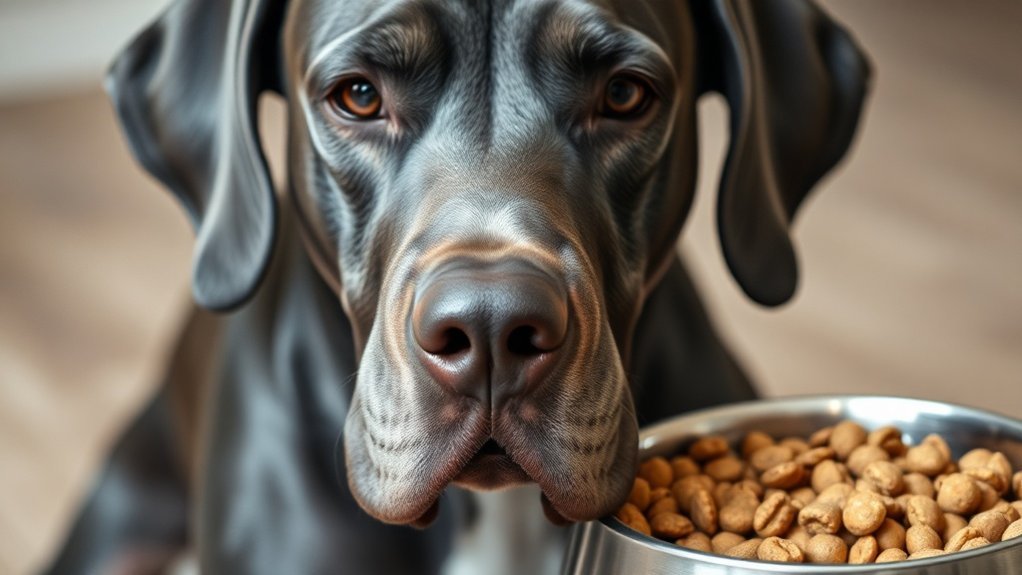When Kibble Turns into Trouble

Great Danes & Food Allergies
Woof! Let me tell you about us, Great Danes, and our picky tummies. We’re giant babies when it comes to food allergies, and trust me, it’s no fun being this big AND this sensitive!
So here’s the deal – we Great Danes are like the drama queens of the dog world when it comes to certain foods. While your average little Chihuahua might handle beef, chicken, lamb, and dairy just fine, we turn into itchy, uncomfortable messes. It’s as if our giant bodies have decided to be extra dramatic about everything, including what we eat.
When we eat something that doesn’t agree with us, boy, do we let everyone know! First, we start scratching like we’re trying to win a scratching contest. Our skin gets all red and angry, and we can’t stop itching – it’s torture! Then our stomachs join the rebellion, and let’s say nobody wants to be around when that happens. We’re talking explosive bathroom situations and the throwing up that makes humans run for the paper towels.
Oh, and our ears? They get all gunky and infected, too. It’s like our whole body is throwing a tantrum because we ate the wrong thing.
The good news is that our humans have figured out some tricks. They put us on these boring elimination diets where we eat the same bland food for weeks to figure out what’s bugging us. It’s like being a detective, but way less exciting and with way less tasty evidence.
Sometimes we get these special hydrolyzed protein foods that are pre-chewed proteins that our digestive systems can handle. They’re not winning any taste awards, but at least we’re not scratching ourselves silly or having bathroom emergencies.
Typical Food Allergens That Affect Great Danes
Let me tell you, being a giant dog comes with big problems, especially when it comes to what goes in my food bowl. Us Great Danes have pretty sensitive tummies, and some foods don’t agree with us at all.
Take chicken, for example. I know, I know – it sounds crazy that a dog mightn’t like chicken! But sometimes when I eat it, I get all itchy and my belly feels terrible. My human says it’s because my body thinks the chicken proteins are bad guys trying to invade, so it fights back really hard. Not fun when you’re just trying to enjoy dinner!
Beef can be just as tricky. One day I’m happily chomping on a beef treat, and the next day I’m scratching like I’ve got fleas (which I don’t, thank you very much). My skin gets all red and bumpy, and my stomach starts doing backflips. To make matters worse, some high-quality protein sources can also trigger these reactions.
Don’t even get me started on milk and cheese! Sure, that ice cream cone looks delicious, but my giant body can’t handle dairy very well. I’m having trouble digesting the milk sugar, and the proteins in the milk make me feel sick. Trust me, you don’t want to be around when a Great Dane has an upset stomach!
Bread and wheat stuff can make my intestines all angry and inflamed. And soy? It takes a while, but eventually it makes me feel pretty awful too. Even some fish like salmon can make me break out in hives – imagine a spotted Great Dane!
The best way to figure out what’s bothering my belly is to try the elimination diet. That’s when my human takes away all the suspect foods and slowly adds them back one by one. It’s like being a food detective, but way less fun because I’ve to eat bland food for a while. This process is crucial for diagnosing food allergies and helps ensure my meals won’t turn into a tummy disaster!
Recognizing Food Allergy Symptoms in Your Great Dane
Look, I know I’m huge and sometimes I act tough, but trust me, when my tummy hurts or my skin gets itchy, I’m not feeling so great. The problem is, humans sometimes miss the signs because we think, “Oh, he’s so big, he can handle anything!” But that’s not always true.
Here’s what you should watch for: First, if I’m scratching myself like crazy, that’s a big red flag. My skin might look red and angry, and sometimes I scratch so much that I get gross infections. Not fun for anyone involved, believe me.
My stomach tells the real story, though. If I’m having runny poops all the time, throwing up my dinner, or making the house smell like a gas station (sorry, not sorry), something’s probably wrong with my food. Foods like low-quality dog food can lead to nutritional deficiencies and exacerbate these issues.
You’ll also catch me doing weird stuff like licking my paws constantly – and I mean CONSTANTLY. It’s like they’re covered in peanut butter, except they’re not. My ears might get gunky and infected, too, which is super annoying when I’m trying to hear the treat bag crinkle.
Sometimes my face puffs up like a balloon, which honestly makes me look pretty ridiculous. The tricky part is that sometimes these symptoms don’t show up right away, so you mightn’t connect them to that new food you gave me last week. Just like with toxic plants, early recognition of symptoms is vital for effective intervention.
Please do me a favor and write down when these things happen. Your vet can help figure out what’s bugging me through special diets or tests. Trust me, catching this stuff early means I’ll be back to my happy, drooling self in no time!
Understanding Protein Allergies in Giant Breeds
So here’s the deal – us giant breed dogs like me have some special challenges when it comes to food allergies. Because we’re so big and our bodies work fast, we tend to get worse allergic reactions than our tiny cousins. It’s like everything is super-sized with us, including the sneezing and itching!
The usual suspects that make us feel yucky are beef, chicken, lamb, and dairy products. I know, I know – it’s unfair that some of the yummiest stuff is off-limits. Our big bellies absorb these problem proteins easily, which means the allergic reactions spread throughout our whole body. Not fun when you’re already trying to navigate doorways without bumping your head!
The good news is that there are solutions! My vet put me on something called an elimination diet. I got to try new and exciting proteins like venison and duck. I felt like a fancy restaurant critic, except with more drooling. It’s also essential to consider caloric requirements to ensure we maintain a healthy weight while figuring out our food sensitivities. Additionally, a diet rich in high-quality protein can help support overall health and muscle development during this process.
Some dogs even get special hydrolyzed proteins, which are proteins that have been broken down so small that our immune systems don’t recognize them as troublemakers.
My humans also got me tested with either skin tests or blood work to figure out exactly what was bothering me. Once we knew the culprits, we could avoid them, and I felt so much better! No more itchy paws or upset stomach.
If you’re a fellow giant breed dealing with this stuff, hang in there! With the right food changes, you’ll be back to your happy, tail-wagging self in no time.
The Grain-Free Diet Controversy and Heart Health Risks
Woof! Let me tell you about something that’s been making us Great Danes pretty worried lately. Between 2014 and 2018, a bunch of my big buddies started getting sick with something called dilated cardiomyopathy – that’s a fancy way of saying our hearts got weak and flabby. Not good when you’re already the size of a miniature horse like me!
Here’s the thing that gets my tail in a twist – the dog doctors noticed that a lot of us sick pups were eating those trendy grain-free foods. You know, the ones with peas, lentils, sweet potatoes, and weird meats like kangaroo (seriously, who thought that was a good idea?).
Our humans fell for some silly stories about how grains would give us allergies, so they switched our food, thinking they were helping us out.
But guess what? Those grain-free diets were messing with important stuff in our bodies called taurine and amino acids. Without enough of these, our big hearts started having significant problems. Talk about a plot twist nobody saw coming!
Now the smart vet people are telling our humans to skip the grain-free stuff unless we need it for medical reasons. The heart problems are way scarier than any imaginary grain allergies. Who knew? Additionally, maintaining a healthy lifestyle through regular exercise with us Great Danes can help promote overall heart health.
All this time, we could have just stuck with regular dog food and kept our ticker healthy. Lifelong management of our health is essential for preventing complications, just like how the best toy is always a good old tennis ball!
Effective Management and Treatment Strategies
How My Humans Help Me Feel Better When Food Makes Me Itchy****
Woof! Let me tell you what happens when my humans figure out that my dinner is making me scratch like crazy. First, they did this thing called an elimination diet where I only got to eat bland food for weeks. Not fun, but hey, at least I still got treats (special ones, of course).
When they confirmed I’m allergic to my old kibble, my vet human started giving me medicine to stop the itching right away. Some pills are called antihistamines that make me less scratchy, and sometimes stronger stuff called corticosteroids when I’m having a rough day.
Then comes the fun part – new food! My humans switched me to special hypoallergenic kibble. It contains fancy “hydrolyzed proteins” (basically, proteins chopped up so small that my body can’t recognize them as enemies) or completely new protein sources I’ve never eaten before. Turkey? Duck? Sometimes even a kangaroo! Who knew dinner could be so exotic? They also ensure I get nutritional value from my meals by including ingredients like pumpkin, which is great for my digestion.
But wait, there’s more! My humans add omega-3 oils to my food bowl – it’s supposed to help my tummy work better and keep my immune system from going bonkers. High-quality protein sources are essential for my diet to ensure I get all the nutrients I need while avoiding allergens.
They also give me probiotics, which are like tiny good guys that live in my belly and fight the bad stuff.
The coolest part is getting digestive enzymes sprinkled on my food. They help me absorb all the good nutrients while keeping the allergic reactions away.
My humans watch me super closely during all these changes, adjusting my meals based on how I’m feeling. No more mystery ingredients for this Great Dane!
Final Thoughts
So here’s the deal: about 10-15% of us dogs get itchy, scratchy skin because of something we’re eating. And us giant breeds? We’re even MORE likely to have food troubles! Why? Well, we’ve got super-fast metabolisms (we burn through food like a race car burns gas), and our digestive systems are HUGE. That’s a lot of belly real estate where things can go wrong!
The worst part is when people started saying grain-free food might cause heart problems in dogs like me. Talk about confusing! One day, grains are bad, the next day, they might be good? Make up your minds, humans!
But don’t worry – the intelligent humans in white coats have figured out ways to help us. They do these things called elimination diets (which is fancy talk for “let’s try different foods until we find one that doesn’t make you itchy”). They also do blood tests to see what makes our immune systems go crazy.
The best part? They watch our hearts super carefully while figuring out our food situation. Because let’s face it – when you’re 150 pounds of pure love like me, you need a strong ticker to carry all this awesome around!
So if your Great Dane is scratching like crazy, don’t panic. We can figure this food thing out together!
References
- https://americannaturalpremium.com/breed-guide/great-dane-food-allergies-symptoms-solutions/
- https://grdane.com/great-dane-food-allergies/
- https://greatdanecare.com/grain-free-food/
- https://www.akc.org/expert-advice/nutrition/dog-food-allergies/
- https://www.petmd.com/dog/nutrition/are-grain-free-diets-bad-for-dogs







18 Comments